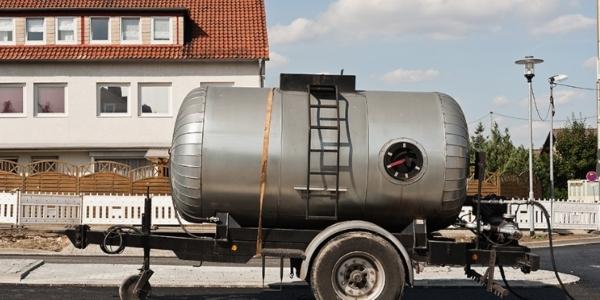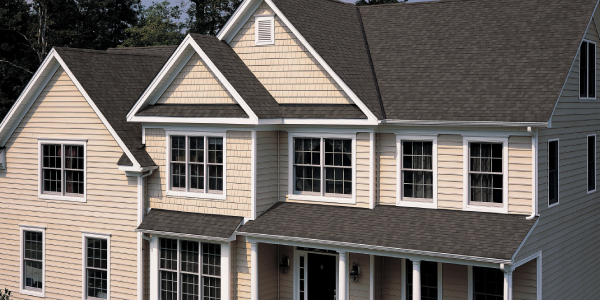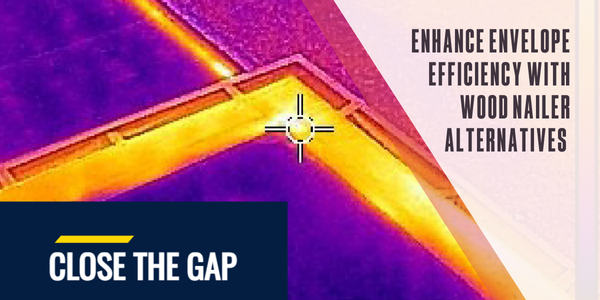Controlling Kettle and Maintaining the Temperature of Hot Asphalt in Cold Weather Commercial Roof Applications

By IKO.
The quality of a roof depends on proper installation techniques.
Disclaimer: Hot mopping on asphalt roofs is highly dangerous. Proper safety training is necessary to perform this job. When choosing the temperature for your hot tar roofing kettles, always follow the manufacturer’s requirements and do not heat the kettle beyond the ATSM D312’s maximum kettle temperature. It is incumbent upon the roofing professional to determine and maintain a safe temperature.
In order to properly install built‐up roofing systems (BURs) and other asphalt roof systems with hot mopping, you must heat the asphalt to the correct temperature in the kettle and apply it to the roof at its application temperature. However, this is more challenging in the winter. Cold air can rob the asphalt of its heat between the roofing kettle and the roof’s surface. At low temperatures of -7 degrees C to 4 degrees C (20-39 degrees F), asphalt temperature may drop 20 degrees C (50 degrees F) in a matter of seconds.
If the asphalt is applied below the ideal temperature, it may be too thick to apply evenly or seal properly to the base sheet or to itself. In order to compensate for this problem when hot mopping in the winter, many roofing professionals choose to heat their hot tar roofing kettle above the appropriate temperature. While this strategy works at first, the longer the installation job, the more the high temperatures take a toll on the asphalt, actually reducing its quality and ability to seal properly.
There are other disadvantages and risks to overheating asphalt that you should know about. Plus, there are techniques you can use instead of overheating the kettle that may also increase your efficiency as well as the quality of your roof. Read on to discover those techniques.
Asphalt Installation Temperatures
The proper temperature to heat asphalt before hot mopping is referred to as the equiviscous temperature (EVT). At this temperature, the asphalt is viscous enough to be mopped out evenly, but not too thin that it runs uncontrollably. This viscosity is measured in centipoise (cP). The ideal viscosity for hand mopping is 125 cP. For mechanical mopping, a lower viscosity, of 25 cP, is required. Manufacturers produce different asphalt products that may be thicker or thinner than average. Therefore, each product may have a different EVT. Manufacturers should inform you of that EVT, so that you can get the best results from their product.
However, as a general principle, the Canadian Roofing Contractors Association’s (CRCA) National Technical Committee suggests that SBS modified bitumen should be heated to 200 degrees C (400 degrees F), or the EVT as listed by the manufacturer, whichever is higher.
You can also determine the proper temperature for asphalt application by following the ASTM D312 guidelines. Determine your material’s ASTM type (the manufacturer may list it) and use the following chart as a guide:
|
Asphalt by ASTM Type |
Roofing Kettle Temperature |
Application Temperature in BUR Systems |
Flash Point |
|---|---|---|---|
|
I IKO’s Asphalt Type One |
218°C (425°F) |
168°C – 207°C (335°F – 405°F) |
246°C (475°F) |
|
II IKO’s Asphalt Type Two |
232°C (450°F) |
177°C – 213°C (350°F – 415°F) |
246°C (475°F) |
|
III IKO’s Asphalt Type Three |
260°C (500°F) |
185°C – 224°C (365°F – 435°F) |
246°C (475°F) |
|
IV |
260°C (500°F) |
204°C – 246°C (400°F – 475°F) |
246°C (475°F) |
There’s also a maximum roofing kettle temperature that you should not exceed. The ASTM D312 dictates that kettle temperature should be below 288 degrees C (550 degrees F). Ideally, you would keep your roofing kettle as low as possible within the EVT range, never approaching this temperature.
Problems of Overheating
What are the dangers and disadvantages of exceeding the EVT range or even the maximum kettle temperature?
-
Lowered softening point of asphalt: Light oils in the asphalt give the material its ability to soften and seal properly. If the asphalt is overheated, these oils evaporate, and the material becomes brittle and hard. The longer the asphalt is exposed to high temperatures, the more serious this effect becomes. With a lowered softening point, the asphalt is more likely to crack after application and may fail to seal. One way to counteract this effect is to keep the roofing kettle lid closed when possible so that the evaporating oils are trapped and are more likely to mix back into the asphalt.
-
Poor application: Overheated asphalt may become harder to apply. Even a flat roof has a very slight slope, in order to create positive drainage. Asphalt that is too hot and too viscous may slide along this slope, becoming uneven, or even damaging the other layers of the roof. Later, after cooling, the asphalt is more likely to develop blisters or suffer uneven bumps and ridges, called “alligatoring.” These are not just visual blights; they are poor applications that may affect the performance of the roof.
-
Risk of ignition: Asphalt that is too hot may reach what is called a “flashpoint” or the temperature at which the asphalt may ignite in the air. This is exceptionally dangerous and must be avoided in order to keep roofers and building occupants safe from fires.
-
Increased fumes: As the asphalt is overheated, it releases more fumes. In fact, it may even release a blue smoke. These excess fumes may be hazardous for roofers and building occupants.
Choosing the Right Conditions
Instead of overheating your hot-tar roofing kettles, one solution is to hot mop roofs under more ideal conditions that allow the asphalt to maintain more heat.
Wind speed is one important variable. Fast winds can increase the rate at which the asphalt cools by blowing away heat. Choosing an installation date with lowered wind speeds will help the liquid asphalt maintain heat.
Of course, the most critical weather condition is temperature. In cold climates, applying a hot-mop roof during winter weather may be unavoidable. If you must apply a hot-mopped roof in cold temperatures, you can reduce the stress on the asphalt by choosing one with a higher softening point. However, it should not be attempted at all when temperatures are below -26 degrees C (-15 degrees F). At these temperatures, asphalt materials simply cannot be applied properly.
Methods of Maintaining Asphalt Heat
There are strategies you can use instead of overheating that can help the asphalt maintain its EVT. Plus, these strategies can also increase your overall efficiency and the quality of your roof. They may even reduce your operating costs.
-
Double‐jacketed roofing kettles: Insulated kettles, especially those with large capacities, will maintain heat. They will also achieve that heat faster, which can help speed up your operation. Plus, if your roofing kettle is well‐insulated, it will require less fuel to achieve proper heat, which saves you money.
-
Insulated lines: If you’re using lines to deliver the asphalt across a large roof to where it is needed, ensure those lines are insulated to maintain heat.
-
Insulated mop buckets and hot luggers: Hot luggers are preferred to mop buckets as they are closed and maintain heat better.
-
Reduce trip distance: Seek to get the hot asphalt as close as possible to its application point before it has to leave an insulated container. This will help it maintain heat and may help you perform the installation faster.
Decisions in the Field
Research from the National Roofing Contractors Association (NRCA), called “Practical Application of the EVT Concept,” has found that cold weather applications may require the roofer to adjust the EVT of the asphalt in the field. They also suggest that roofers should choose, when possible, viscosity stable asphalts and that manufacturers should indicate the stability of their products.
IKO lists the EVT of our asphalt products for both hot mopping and mechanical operation. We also list flash point, the softening point of our asphalt and many other useful values in the product data sheets for our commercial asphalt products. Our Easy‐Melt™ 200 Asphalt is a convenient type III asphalt that doesn’t need to be unwrapped and is only half the weight of an asphalt keg. If you’re not sure which asphalt type is right for your next roof job, please contact us.
Get more information on becoming an IKO commercial installer.
Original article source: IKO






















Comments
Leave a Reply
Have an account? Login to leave a comment!
Sign In